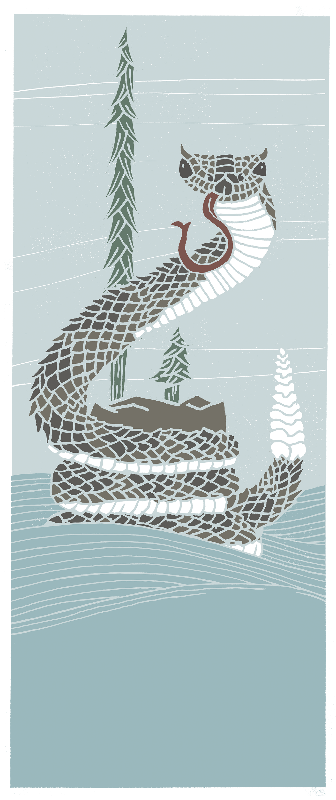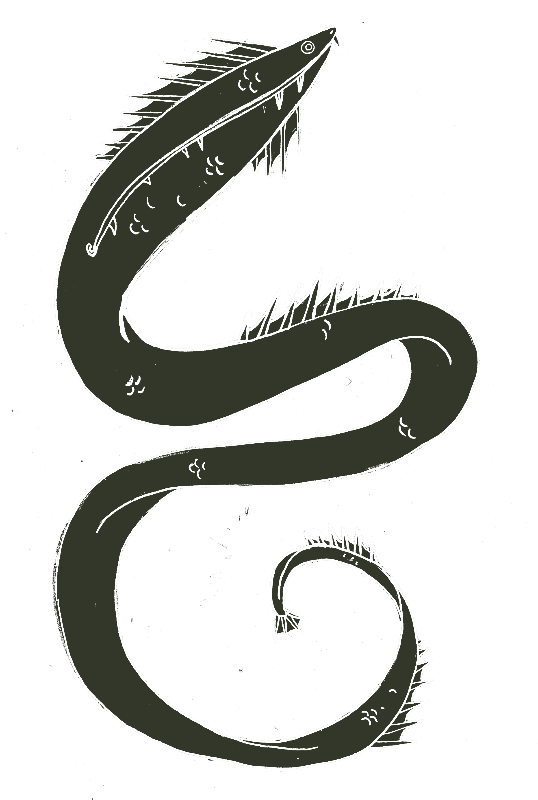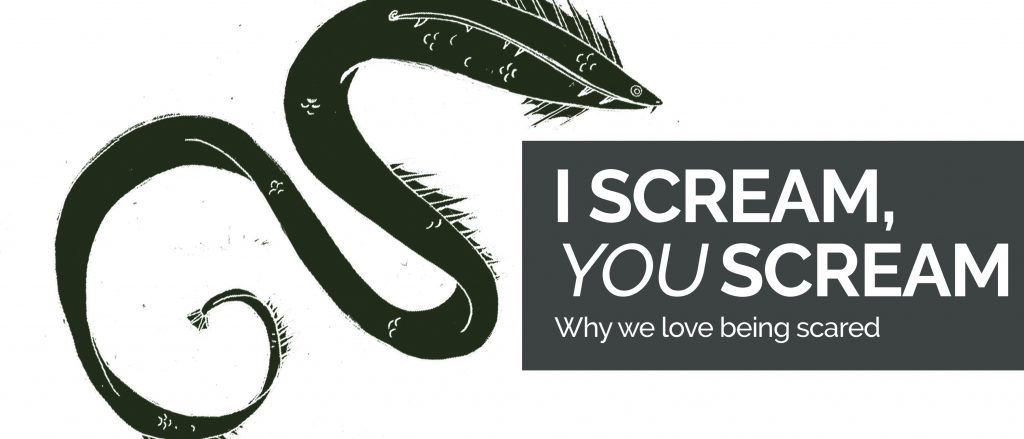




— illustrations courtesy of Mike Bass. You can find Bass’s work at zip-dang.com.
 Legend has it, in the early years of Wisconsin logging, a monster lurked in the dark woods. His thick legs thudded on the forest floor, and his spiked tail rustled in the fallen leaves. Today, we know this creature as the harmless Hodag, but even the brave men who risked their lives lumbering were terrified of this mysterious beast.
Legend has it, in the early years of Wisconsin logging, a monster lurked in the dark woods. His thick legs thudded on the forest floor, and his spiked tail rustled in the fallen leaves. Today, we know this creature as the harmless Hodag, but even the brave men who risked their lives lumbering were terrified of this mysterious beast.
It turns out that scary stories are more multifaceted than we knew. They can satisfy emotional needs, bond us together, allow time for reflection and inform us of other cultures’ customs, all while helping us face our fears. But too much fear can be a bad thing for our well-being.
We thrill in scary stories, whether they’re told around a campfire or in the pages of a book, whether we experience them on screen or cowering through a haunted house. We put ourselves in vulnerable positions in pursuit of eliciting a reaction that, in the end, will make us happy. It’s like the old adage says: What brings us pain also brings us pleasure.
That backward logic has a purpose, says Joanne Cantor, a UW-Madison professor of communication arts and expert on the psychological impact of the media relating to fear and violence. We’re willing to subject ourselves to fear due to our innate interest in death and dying, otherwise known as morbid curiosity.
“There’s something about us that is very curious about death and dying,” Cantor says. “A lot of scary things involve the threat of death or dying … we might get sick to our stomach or something, but that compels people to want to watch.”
Karyn Riddle, UW-Madison assistant professor of journalism and mass communication and expert on the effects of exposure to media violence, says a reason we like being scared is that it fulfills a meta-emotion. Meta-emotions are how we react to feeling a certain way.
“It’s another level of emotion. I’m really scared right now, and on a meta level I like that. For some people, they like that. Like ‘I’m enjoying the fact that I’m scared,’” Riddle says.
Satisfying morbid curiosities and meta-emotions helps explain our attraction to fear. But being scared is almost always a shared experience, one we use to bond with one another.
“People find it as a way of becoming closer to each other, as we are in a safe environment where we know we really aren’t [in danger], but we need each other to help us go through this scary thing,” Cantor says.
Ruth Olson, associate director of the Center for the Study of Upper Midwestern Cultures, uses the example of legend tripping as a scary thing people do to bond.
Legend tripping is typically a venture for adolescent kids to go on a quest to a cemetery or haunted house in hopes of witnessing paranormal activity, Olson says.
“It’s definitely a social thing because think about it, do people like to be scared in solitary? No. Nobody wants that,” Olson says.
We put ourselves through being scared as a bonding experience with other humans. We even do it to spark romantic bonds. There have been studies on viewing horror films that suggest people of the opposite sex, assuming they are heterosexual, like being scared together, Riddle says.
“Men in particular like horror films, and they really like it when they’re watching with a girl. If they’re straight, they like watching it with a girl who’s frightened and that allows them to feel strong and protective,” Riddle says.
Sharing our scary experiences also allows for a time of reflection. One subcategory in the folklore genre are memorates or “stories of experiences that people have had that they cannot explain,” Olson says.
Olson sees in her class when students share frightening things that happen to them, and their peers respond in ways that make them think deeper about what happened and the meaning behind it.
“There’s always somebody who offers explanations [after a story] ‘who says, here’s what I think happened,’” Olson says. “It becomes a time for reflection and analysis that kind of helps us judge how we think about things.”
The folklore genre also contains folktales and other more traditional stories. Many times, these stories have an underlying theme or lesson in them that teaches us something or gives insight into a culture.
Tomislav Longinović, UW-Madison Slavic and comparative literature professor and East European folklore expert, says folklore stories were told orally before people could read or write, and they came from the imagination of the common people.
When we study how stories originate, we see that the scary monsters or creatures are personifications of common human fears like hunger, war and famine, Longinović says.
Folklore is important because, “it keeps us seeing the connection to the roots of a particular culture … so that we can have a sort of continuity in terms of a collective identity,” Longinović says.
But there are also negative effects that come from subjecting ourselves to fear.
When we are scared, a small, almond-shaped part of the brain called the amygdala becomes stimulated as it processes the images we see. The scarier the image, the more the amygdala is stimulated, sending a greater fear response throughout the body, Cantor says. For example, a loud noise might make you jump, whereas a person grabbing you in the woods at night could make you scream.
The amygdala also stores memories. This ability is dangerous because especially terrifying experiences are stored in the brain and can be triggered at any time, causing nightmares, sleeplessness and heightened anxiety that can be detrimental to our overall health.
“[Fear] can interfere with your sleep if you have repeated nightmares or can’t get to sleep over and over again, that’s physically bad for you … it also can lead to getting sick and it might interfere with activities that you otherwise would find fun"
For this reason, it is important to monitor how much we subject ourselves to scary things, especially when it comes to children, Cantor says.
Both folklore and how we experience fear have changed over time, mainly due to the increased accessibility to stories and the platform the internet provides for sharing these stories.
Olson uses the 2014 Slender Man stabbing in Waukesha, Wisconsin, a suburb of Milwaukee, as an example to illustrate how narratives surrounding fear can get out of control.
An online chat dedicated to the fictitious Slender Man provided a space where people could participate in collaboratively building a story about the evil creature. Contributors added to the narrative for fun and entertainment, but the story became too believable for two middle school girls who ended up committing a terrible act against one of their peers, Olson says.
There is a fine line between how much fear is good for our existence and how much is harmful. The trick is finding the perfect balance.
“I think just the right amount of being frightened or scared may be entertaining,” Cantor says. “And also if you are afraid of something, maybe just the right dosage of scary, but with a twist that makes it less scary, can help you deal with your fears.”
Still, there are ways of taking fear into our own hands that are constructive and enjoyable.
Mike Bass, artist and owner of Madison’s art and gift shop Zip-Dang, says folklore is community. People like sharing things that supposedly happened to them or they have seen. And when certain monsters are associated with a place, the community in that town or village takes pride in the myth.
“I think there’s that combination of people or a group of people who have a story that belongs to them and to see it told over and over and over again kind of just validates their existence,” Bass says.
Bass has created a collection of illustrations in an ongoing series he calls Wisco-Mythos. Designed as a combination of history and people’s imaginations, the illustrations seek to explain things we don’t understand.
“You hear a bump in the night, you see something floating in the lake that’s bigger than your average fish. Things move that you don’t expect to move. You have to explain that in a way,” Bass says. “So by explaining it, you are kind of somewhat conquering your fear even though you’re feeding your fear.”
As a Wisconsin native and someone who believes there were spirits in the house where he grew up, Bass has always had an interest in folklore.




“Wisconsin is such a folklore-rich state because we had huge forests,” Bass says. “If you think about when the state was first being explored, the forest must have been just immense and deep and dark. I think that that just instilled a lot of fears and creative stories for explaining things in our history here in Wisconsin.”
Some of his illustrations include the Bray Road Beast, the Hodag, the Rattlesnake of Governor’s Island and the Mendota Monster.
Bass says we can enjoy scary things in a controlled environment. Fear isn’t something people are actively looking for, but they can read a book or watch a movie or look at art with friends in a safe place. These things give you the willies but don’t actually threaten you.
It’s good to make your heart pound once in a while. We can make fear fun and get our adrenaline pumping without damaging our psyche – it just takes balance. Too much of a good thing isn’t a good thing, but the right amount can add a bit of excitement to our lives.

Our engagement director, Ashley, is a senior majoring in journalism and strategic communications. She loves being outdoors and draws inspiration from nature. Upon graduation, Ashley hopes to write for a fashion, lifestyle or travel magazine.